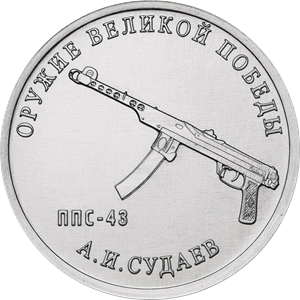Weapons Designer Aleksey Sudaev
Obverse
in the centre there is a relief image of the National Coat of Arms of the Russian Federation and over it a semicircular inscription along the rim: "РОССИЙСКАЯ ФЕДЕРАЦИЯ" (RUSSIAN FEDERATION) framed by doubled rhombuses on both sides, under the emblem, in three lines, there is an inscription: "БАНК РОССИИ" (BANK OF RUSSIA), the coin’s par value "25 РУБЛЕЙ" (25 RUBLES), and the year of issue "2020 г." (2020), and on the right there is a mint trade mark.
Reverse
a relief image of the Sudaev submachine gun and the inscription ‘ППС-43’ (PPS-43) on the bottom left; along the rim there are the inscriptions ‘ОРУЖИЕ ВЕЛИКОЙ ПОБЕДЫ’ (WEAPONS OF THE GREAT VICTORY) at the top and ‘А.И. СУДАЕВ’ (ALEKSEY SUDAEV) at the bottom.
Authors
Designers: E.V. Kramskaya (obverse), A.V. Gnidin (reverse).
Sculptors: A.A. Dolgopolova (obverse), computer simulation (reverse).
Mint: Moscow Mint (ММД).
Edge: 180 corrugations.
Discover more
Aleksey Ivanovich Sudaev (1912–1946) was a Soviet weapons designer who developed a submachine gun that was accepted for service in 1942 under the name ‘7.62 mm Sudaev submachine gun, 1942 design’ (PPS-42) and in 1943, after a number of improvements, under the final name of PPS-43.
By the time of the adoption of the Sudaev submachine gun, the Soviet Army had already actively used the Shpagin submachine gun, PPSh-41, which had proved itself as one of the best Soviet firearms. However, due to its weight and size it was ill suited for use in confined areas: in trenches, guerrilla hideouts, military vehicles, or during reconnaissance raids and airdrop missions. A tender was announced to design a new submachine gun that would be light and compact while retaining the combat qualities of the PPSh. Aleksey Sudaev was able to develop just the gun. The PPS-43 was much lighter and more compact, more manoeuvrable, more reliable and easier to use and maintain than the PPSh-41. Low firing speed was another notable plus of the PPS-43, as it allowed soldiers to save ammunition and, with certain skills, fire single rounds.
The PPS-43 was also much more technologically advanced: its manufacturing required much less metal and labour, which made it possible to set up its mass production in Leningrad during the blockade.
Despite obvious advantages, the PPS-43 failed to become the main submachine gun of the Great Patriotic War. The production of the legendary PPSh-41 was already well established, and it was considered infeasible to make changes to technological processes during the war to manufacture the new weapon. However, it was the light and reliable PPS-43 that was praised as the best submachine gun of the Great Patriotic War by many military experts.


